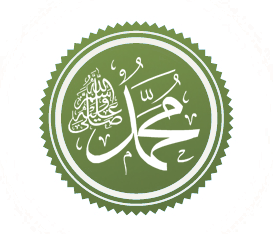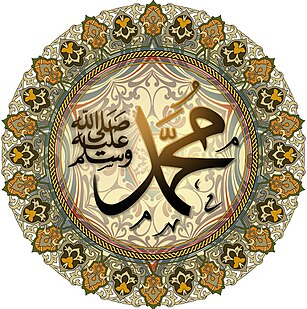
Muhammad was an Arab religious, social, and political leader and the founder of Islam. According to Islamic doctrine, he was a prophet, sent to present and confirm the monotheistic teachings preached previously by Adam, Abraham, Moses, Jesus, and other prophets. He is viewed as the final prophet of God in all the main branches of Islam, though some modern denominations diverge from this belief. Muhammad united Arabia into a single Muslim polity, with the Quran as well as his teachings and practices forming the basis of Islamic religious belief. He is referred to by many appellations, including Messenger of Allah, The Prophet Muhammad, Allah's Apostle, Last Prophet of Islam, and others; there are also many variant spellings of Muhammad, such as Mohamet, Mahamad, Muhamad, and many others.

Medina, also transliterated as Madīnah, is the capital of the Al-Madinah Region in Saudi Arabia. At the city's heart is al-Masjid an-Nabawi, which is the burial place of the Islamic prophet, Muhammad. Medina is one of the three holiest cities in Islam, the other two being Mecca and Jerusalem.
Satanic Verses refers to words of "satanic suggestion" which the Islamic Prophet Muhammad is said to have mistaken for divine revelation. The alleged verses can be read in biographies of Muhammad by al-Wāqidī, Ibn Sa'd and Ibn Ishaq, and the tafsir of al-Tabarī.
Ummah is an Arabic word meaning "community". It is distinguished from Shaʻb which means a nation with common ancestry or geography. Thus, it can be said to be a supra-national community with a common history.

The Battle of Badr, fought on Tuesday, 13 March 624 CE in the Hejaz region of western Arabia, was a key battle in the early days of Islam and a turning point in Muhammad's struggle with his opponents among the Quraish in Mecca. The battle has been passed down in Islamic history as a decisive victory attributable to divine intervention, or by secular sources to the strategic genius of Muhammad. It is one of the few battles specifically mentioned in the Quran. All knowledge of the battle at Badr comes from traditional Islamic accounts, both hadiths and biographies of Muhammad, recorded in written form some time after the battle. There is little evidence outside of these of the battle. There are no descriptions of the battle prior to the 9th century.
The Hegira is the migration or journey of the Islamic prophet Muhammad and his followers from Mecca to Yathrib, later renamed by him Medina, in the year 622. In May 622, after being warned of a plot to assassinate him, Muhammad secretly left his home in Mecca to emigrate to Yathrib, 320 km (200 mi) north of Mecca, along with his companion Abu Bakr. Yathrib was soon renamed Madīnat an-Nabī, but an-Nabī was soon dropped, so its name is "Medina", meaning "the city".
Muhammad's wives, or the wives of Muhammad, were the women married to the Islamic prophet Muhammad. Muslims often use the term "Mothers of the Believers" prominently before or after referring to them as a sign of respect, a term derived from the Quran.

The successful military career of Muhammad, the prophet of Islam, lasted for the final ten years of his life, from 622 to 632. After he and his small fellowship were pushed out of the holy trading town of Mecca, controlled by the powerful Quraish tribe, he started intercepting Meccan caravans. After his first victory in a pitched battle at Badr in 624, his power grew increasingly and he began to influence other tribes through either diplomacy or conquest. In 630 he finally accomplished his long-term goal of conquering Mecca and the Kaaba. By his death in 632, Muhammad had managed to unite most of the Arabian Peninsula, laying the foundation for the subsequent Islamic expansion.

Al-Anbiyāʼ, properly pronounced: Al-Ambiyāʼ is the 21st chapter (sūrah) of the Qur'an with 112 verses (āyāt). Regarding the timing and contextual background of the supposed revelation, it is an earlier "Meccan surah", which means it is believed to have been revealed in Mecca, instead of later in Medina. Its principal subject matter is prophets of the past, who also preached the same faith as Muhammad.

An-Naml is the 27th chapter (sūrah) of the Qur'an with 93 verses (āyāt).

The Battle of Uhud was a battle between the early Muslims and their Qurayshi Meccan enemies in 624 CE in the Hejazi region of the Arabian peninsula.
Muhammad at Medina is a book about early Islam written by the non-Muslim Islamic scholar W. Montgomery Watt. Published at 418 pages by Oxford University Press in 1956, it is the sequel to Watt's 1953 volume, Muhammad at Mecca.

The Migration to Abyssinia, also known as the First Hegira, was an episode in the early history of Islam, where Prophet Muhammad's first followers fled from the persecution of the ruling Quraysh tribe of Mecca. They sought refuge in the Christian Kingdom of Aksum, present-day Ethiopia and Eritrea, in 9 BH or 7 BH. The Aksumite monarch who received them is known in Islamic sources as the Negus Ashama ibn Abjar. Modern historians have alternatively identified him with King Armah and Ella Tsaham. Some of the exiles returned to Mecca and made the hijra to Medina with Muhammad, while others remained in Abyssinia until they came to Medina in 628.

Mount Uhud is a mountain north of Medina, Saudi Arabia. It is 1,077 m (3,533 ft) high. It was the site of the second battle between Muslim and unbelievers. The Battle of Uhud was fought on 19 March, 625 CE, between a force from the small Muslim community of Medina, in what is now north-western Arabia, and a force from Mecca.
The Banu Qaynuqa was one of the three main Jewish tribes living in the 7th century of Medina, now in Saudi Arabia. In 624, the great-grandfather of Banu Qaynuqa tribe is Qaynuqa ibn Amchel ibn Munshi ibn Yohanan ibn Benjamin ibn Saron ibn Naphtali ibn Hayy ibn Moses and they are descendant of Manasseh ibn Joseph ibn Jacob ibn Isaac son of Abraham. They were expelled during the Invasion of Banu Qaynuqa, after breaking the treaty known as the Constitution of Medina.

Muḥammad ibn ʿAbdullāh ibn ʿAbdul-Muṭṭalib ibn Hāshim, commonly known as Muhammad, is the seal of the Messengers and Prophets of God in all the main branches of Islam. Muslims believe that the Quran, the central religious text of Islam, was revealed to Muhammad by God, and that Muhammad was sent to restore Islam, which they believe to be the unaltered original monotheistic faith of Adam, Abraham, Moses, Jesus, and other prophets. The religious, social, and political tenets that Muhammad established with the Quran became the foundation of Islam and the Muslim world.

The Islamic prophet Muhammad came to Medina following the migration of his followers in what is known as the Hijra in 622. He had been invited to Medina by city leaders to adjudicate disputes between clans from which the city suffered. He left Medina to return to and conquer Mecca in December 629.

The Islamic prophet Muhammad was born and lived in Mecca for the first 52 years of his life. Orphaned early in life, he became known as a prominent merchant, and as an impartial and trustworthy arbiter of disputes. He married his first wife, the wealthy 40-year-old widow Khadijah at the age of 25. He would also marry Aisha and many others later in his life.

Muhammad is documented as having engaged as a diplomat during his propagation of Islam and leadership over the growing Muslim Ummah (community). He established a method of communication with other tribal or national leaders through letters, assigned envoys, or by visiting them personally, such as at Ta’if. Instances of written correspondence include letters to Heraclius, the Negus and Khosrau. Although it is likely that Muhammad had initiated contact with other leaders within the Arabian Peninsula, some have questioned whether letters had been sent beyond these boundaries.

The Islamic prophet Muhammad's views on Jews were informed through the contact he had with Jewish tribes living in and around Medina. His views on Jews include his theological teaching of them as People of the Book, his description of them as earlier receivers of Abrahamic revelation; and the failed political alliances between the Muslim and Jewish communities.








